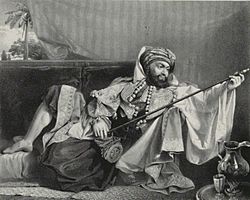George Francis Lyon facts for kids
Quick facts for kids
George Francis Lyon
|
|
|---|---|

"Captain G.F. Lyon in his Tripoline Custome"
|
|
| Other name(s) | Said-ben-Abdallah |
| Born | 23 January 1796 Chichester, England |
| Died | 8 October 1832 (aged 36) Atlantic Ocean |
| Branch | |
| Years of service | 1808–1832 |
| Rank | Captain |
| Commands held | HMS Hecla, HMS Griper |
George Francis Lyon (born January 23, 1796 – died October 8, 1832) was a brave English naval officer and explorer. He traveled to both Africa and the Arctic. Even though his career wasn't super famous, people remember him for his interesting journals and amazing drawings. These notes and pictures were very helpful for other explorers who came after him.
Contents
Early Life and Education
George Francis Lyon was born in Chichester, England. He was the older son of Lieutenant Colonel George Lyon. His mother was Louisa Alexandrina Hart. George went to school at Burney's Academy in Gosport, Hampshire.
Adventures at Sea
George Lyon joined the Royal Navy in 1808. His first ship was HMS Royal William at Spithead. Soon after, he went to sea aboard HMS Milford.
Exploring the Niger River

In 1818, Lyon was sent on an important mission. He joined Joseph Ritchie to find the path of the Niger River. They also wanted to find the famous city of Timbuktu. Their journey started from Tripoli and meant crossing the huge Sahara desert.
Sadly, this trip didn't go well. The expedition didn't have enough money or support. A year later, they had only reached Murzuk. Both Lyon and Ritchie became very sick there. Joseph Ritchie sadly passed away, but Lyon got better. He explored a bit more of the area before returning to Tripoli. The expedition was not successful in its main goals.
Searching for the Northwest Passage

After his return, Lyon wanted the promotion he had been promised. He kept asking the Admiralty (the navy's leaders) until they gave it to him. In 1821, he was given command of HMS Hecla. He joined William Edward Parry on his second try to find the Northwest Passage. This was a sea route connecting the Atlantic and Pacific oceans through the Arctic.
Other important officers on this trip included Henry Parkyns Hoppner, Francis Crozier, and James Clark Ross. When Lyon returned from this expedition, he was promoted to captain.
In 1824, Captain Lyon was given command of HMS Griper. This ship was known for not being very good in the Arctic ice. His new goal was to sail into Hudson Bay. From there, he planned to go north through Roes Welcome Sound to Repulse Bay. Then, he would travel by land to reach a point explored by John Franklin.
The journey was very tough. Hudson Bay was full of ice. On September 1, 1824, a big storm pushed the ship onto a rock or iceberg. Everyone thought the ship would sink, but it stayed afloat. Later, another storm badly damaged the ship's anchors and masts. Lyon spent three weeks carefully guiding the damaged ship out of Hudson Bay. He arrived back in England without anchors, stopping only when his ship got tangled in another ship's ropes.
Later Life and Legacy
Because of this last difficult trip, Captain Lyon didn't get another command in the Royal Navy. However, he was still well-known in society. In 1825, he received an honorary degree from the University of Oxford. He was also chosen to be a Fellow of the Royal Society in 1827.
George Francis Lyon passed away on October 8, 1832. He was on a ship called Emulous, sailing from Buenos Aires back to Britain. He was going home to get treatment for problems with his eyes.
Personal Life and Unique Traits
George Lyon married Lucy Louisa on September 5, 1825. She was the daughter of an Irish revolutionary, Lord Edward Fitzgerald. They had a daughter named Lucy Pamela Sophia Lyon in September 1826. Sadly, Lucy Louisa Lyon died that same month while her husband was away in Mexico. George didn't find out about her death until he arrived back in England. His daughter, Lucy Pamela, later married Reverend Thomas Ovens in 1849 and had three children. She lived until 1904.
One special thing about George Lyon was his true interest in the people he met during his travels. This was quite rare for explorers at that time. In North Africa, he wore local clothes like a thawb and learned to speak Arabic very well. He was even tattooed by the Inuit people in the Arctic, using a needle and sooty thread. He also ate raw caribou and seal meat with them.
Even though his expeditions didn't always achieve their main goals, the information he wrote down about the Inuit tribes was very important. Later scientists, like Franz Boas and Knud Rasmussen, used his journals as a key reference for their own studies.

